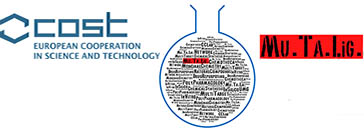
General information
| Name: Susana |
| Surname: Cristobal |
| E-mail: Susana.Cristobal@liu.se |
| Cell phone number with international prefix: + 46730385867 |
| Country: Sweden |
| Affiliation: Linköping University |
| Gender: F X□ M □ |
| Year of the PhD title: 1997 |
| Personal web page: http:// |
| Previous COST participation: No □ Yes □X |
List of 10 selected publications within last 5 years
|
A Campos, G Danielsson, AP Farinha, J Kuruvilla, P Warholm, S Cristobal Journal of proteomics, 2016 137:97-10, |
| Dose-dependent autophagic effect of titanium dioxide nanoparticles in human HaCaT cells at non-cytotoxic levels
Viviana R Lopes, Vesa Loitto , Jean-Nicolas Audinot , Narges Bayat, Arno C. Gutleb, S Cristobal Journal of Nanobiotechnology, 2016, Mar 22;14(1):22. doi: 10.1186/s12951-016-0174-0 |
| Shotgun analysis of the marine mussel Mytilus edulis hemolymph proteome and mapping the innate immunity elements
A Campos, I Apraiz, RR da Fonseca, S Cristobal Proteomics, 2015, 15 (23-24), 4021-4029 |
| Proteomic analyses of early response of unicellular eukaryotic microorganism Tetrahymena thermophila exposed to TiO2 particles
K Rajapakse, D Drobne, D Kastelec, K Kogej, D Makovec, C Gallampois, H Amelina, G Danielsson, L Fanedl, R Marinsek-Logar, S Cristobal Nanotoxicology, 2015, 1-15 |
| Vascular toxicity of ultra-small TiO 2 nanoparticles and single walled carbon nanotubes in vitro and in vivo
N Bayat, VR Lopes, J Schölermann, LD Jensen, S Cristobal Biomaterials, 2015, 63, 1-13 |
| Proteomic and lipidomic analysis of primary mouse hepatocytes exposed to metal and metal oxide nanoparticles
S Tedesco, N Bayat, G Danielsson, X Buque, P Aspichueta, O Fresnedo, S Cristobal Journal of Integrated OMICS, 2015, 5 (1), 44-57 |
| Early response to nanoparticles in the Arabidopsis transcriptome compromises plant defence and root-hair development through salicylic acid signalling
S García-Sánchez, I Bernales, S Cristobal BMC genomics, 2015, 16 (1), 1 |
| Assessment of functionalized iron oxide nanoparticles in vitro: introduction to integrated nanoimpact index
N Bayat, VR Lopes, M Sanchez-Dominguez, R Lakshmanan, GK Rajarao, S Cristobal. Environmental Science: Nano, 2015, 2 (4), 380-394 |
| Folding of Aquaporin 1: Multiple evidence that helix 3 can shift out of the membrane core
MT Virkki, N Agrawal, E Edsbäcker, S Cristobal, A Elofsson, A Kauko Protein Science, 2014, 23 (7), 981-992 |
| The effects of engineered nanoparticles on the cellular structure and growth of Saccharomyces cerevisiae
N Bayat, K Rajapakse, R Marinsek-Logar, D Drobne, S Cristobal Nanotoxicology, 2014, 8 (4), 363-373 |
Main skills and expertise (up to 5)
| 1. Proteomics and mass spectrometry |
| 2. Chemical proteomics |
| 3. Targeting and affinity |
| 4. Toxicology and Nanotoxicology |
| 5. Environmental and human health assessment |
Main equipmentMaldi available in the participants’ lab (up to 5)
| 1. Mass spectrometry ( ESI, Orbitrap) |
| 2. Mass spectrometry ( MALDI,ultraflextreme) |
| 3. Cell Biology Lab |
| 4. Biochemistry Lab |
| 5. Molecular Biology lab |
Short personal activity proposal for the COST Action CA15135 (max 1000 characters)
|
We are presently at the postgenomic era with comprehensive characterization of genome that has turned the focus into the analysis of the dynamics of the proteome. Modulation at the cell function by adjustment of molecular response is the key property to cope with stressors as individual parameter, with disease as multifactorial stressors or with evolution as long-term process. The holistic understanding of those changes requires today the integration of MultiOMICS approaches to reach a deep analysis of physiological/pathological scenarios. Our fundamental research concept is based on integration of comprehensive and cost-efficient methodologies and shortcut strategies that provide a framework to evaluate the molecular and cellular response of nanomaterial, pollutant or small molecules on human health and the environment. Now our interest is focusing on MultiOMICs that defines the integration of different OMICs platform and metaOMICS that deals microbiome and populations and represents one step further from analyze a single organism. Research projects related to the action. Proteomics-based platform for rapid prototyping of nanodrug. Our group has developed methodologies based in lab-in-a chip and mass spectrometry analysis that offer a platform for nanodrug discovery. |
Work Group preference: score from 1 (preferred) to 4 (not preferred)
| Work Group of the CA15135 COST Action | Score |
| WG1: Development of new chemical entities | 1 |
| WG2: Selection of biological targets and assessment of biological data | 1 |
| WG3: Development of chemical databases | 4 |
| WG4: Development of Computational methods for multiple ligand design and discovery | 3 |
